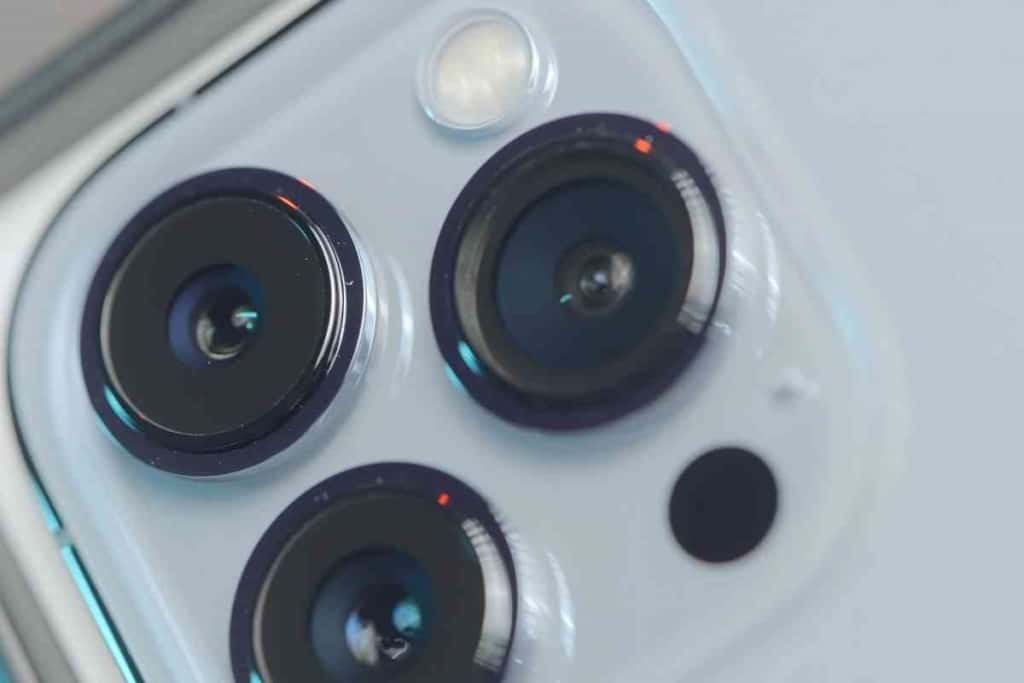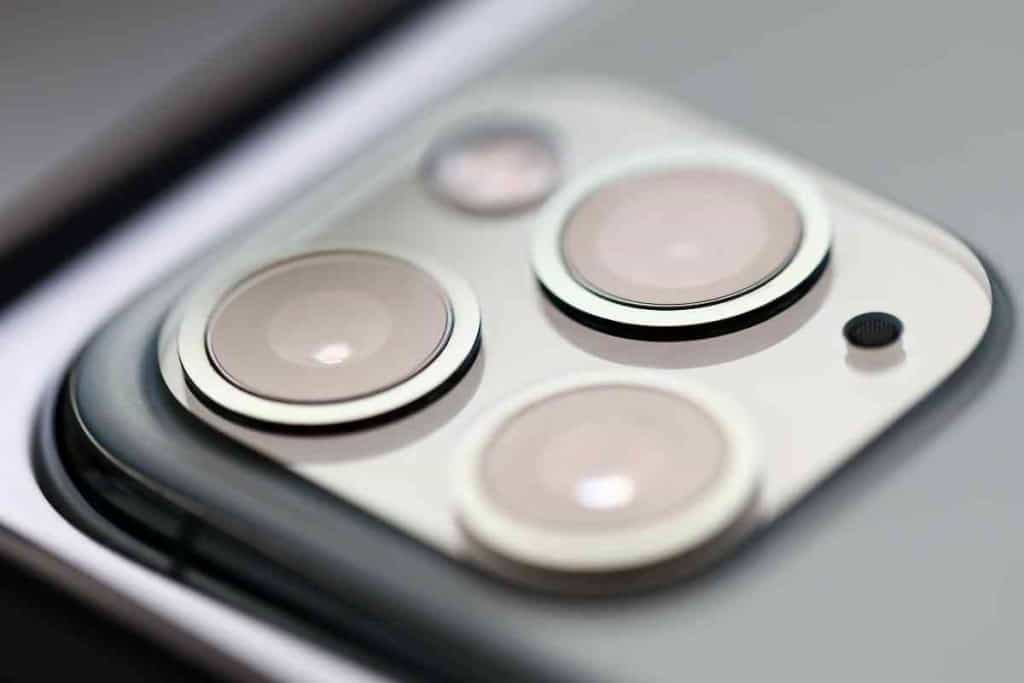Why Does The iPhone Have 3 Cameras? Explained!
If you are not familiar with professional photography or the latest iPhone developments, you might not know why the iPhone has 3 cameras. iPhones and most popular mobile phones have long had only one camera built into it, so it was surprising when an iPhone was released with 3 cameras. Even if you don’t know why an iPhone has 3 cameras, it’s not hard to see how nice photos and videos look when taken with them.

Table of Contents
- Why does my iPhone have 3 camera lenses?
- Why Do Some iPhones Have 3 Cameras?
- What Does Each Of The 3 Cameras On An iPhone Do?
- How Do The 3 iPhone Cameras Help Each Other?
Why does my iPhone have 3 camera lenses?
The iPhone has 3 cameras to take wide, ultra-wide, and telephoto photos and videos. The 3 cameras are synced together for smoother transitions between zoom depths. The cameras also share data for more advanced utilization of lighting, depth of field, and other image elements.
Each camera on the back of an iPhone can detect image elements differently than the other cameras. The iPhone uses sophisticated software and finely tuned engineering to let all three cameras function in a streamlined and coordinated way.
The iPhone user does not need to have any substantive background in photography or videography to use the iPhone cameras for a wide variety of shots. Unlike some traditional cameras, the iPhone also doesn’t require loads of lenses and other attachments to achieve a robust array of high-quality imagery.
Why Do Some iPhones Have 3 Cameras?
An iPhone with a single camera has limitations with respect to zoom, lighting, focus, and other image characteristics.
iPhones that have 3 cameras offer automated tools to help users achieve rich image quality through coordinated sensors and calibrations.
Professional photographers and videographers may often use various cameras and accessories designed for particular shooting purposes
They may use a wide selection of lenses with different focal lengths they can switch out based on the setting and other conditions in front of them.
When I shoot photos and videos with an iPhone that has 1 camera, I get similar user-friendly functionality to an iPhone with 2 or 3 cameras.
However, the range of what I can do and the richness of the images are far greater with the iPhone with 3 cameras.
I have used my iPhone with 1 camera to take the same photo as an iPhone with 3 cameras.
When I compare the two photos side by side, I can notice more dynamic colors and light in the photo taken from the iPhone that has 3 cameras.
Having several friends that are professional photographers and videographers, I feel I can shoot professional photos and videos just as well with an iPhone with 3 cameras.
Even if my framing and other subjective choices aren’t as good as a professional, I can at least get the most out of the images I end up taking.
It’s also far easier to use one light and portable device instead of the many heavy and bulky devices a professional might use.
I can bring an iPhone that has 3 cameras with me virtually anywhere I go with the need for protective cases, bags, or whatever is needed for professional gear.
Though an iPhone with 3 cameras can be quite expensive, it often costs lower than many cameras from brands like Canon, Nikon, Panasonic, or Sony.
The quality of standard high-end cameras compared to an iPhone camera can be debated all day, but one of the main benefits that stand out to me about an iPhone is how much easier it is to use.
What Does Each Of The 3 Cameras On An iPhone Do?

When the iPhone 11 and iPhone 11 Plus were released towards the end of 2019, many consumers were introduced to the first iPhone with 3 cameras on the back.
To be clear, an iPhone 11 and iPhone 11 Plus technically has a total of 4 cameras when you include the front camera, which is often used for selfie-style shooting.
The front camera does not work in conjunction with the other cameras the way the other cameras work with each other.
We’ll go over basic specifications for each of the three back cameras on an iPhone 13 Pro Max to give you a better idea of what they do.
Each of the 3 back cameras on the iPhone 13 Pro Max has varying zoom levels and can shoot up to 12 megapixels.
The Wide Camera On The iPhone
If you are holding an iPhone in the standard upright (or vertical) position, the wide camera is the bottom camera on the back of an iPhone with 3 cameras.
The wide camera is basically the standard camera on an iPhone.
It has been used on previous iPhone models as the lone-back camera.
iPhone models with only a wide camera were capable of shooting great pictures and videos.
The wide camera on an iPhone 13 Pro Max has a focal length of 26mm, which is in between the ranges of the other two back cameras.
If you want to take pictures with a standard field of view, the wide camera is probably your best option.
The wide camera will likely offer a view that’s most familiar to novice camera users.
You can zoom in and out within the wide camera range and maintain sharp images and solid stability.
The Ultra Wide Camera On The iPhone
The ultra-wide camera on an iPhone 13 Pro Max is the middle camera on the back of an iPhone with 3 cameras.
iPhone models with two cameras in the back had a wide and ultra-wide camera.
This camera has a focal length of 13 mm, which is the lowest of the 3 back cameras.
Cameras with a lower focal length mean they can shoot with a wider angle than cameras with a higher local length.
Shooting with the ultra-wide camera allows you to capture more of the view in front of you compared to the wide camera.
In terms of degrees, the ultra-wide camera gives you a field of view of 120 degrees.
Some people may not like the pinched effect of the ultra-wide camera, but it’s a great way to pack more of your view into a shot.
The Telephoto Camera On The iPhone
The telephoto camera is the latest camera to make it on the back of an iPhone.
This new addition greatly elevates the shooting potential for an iPhone.
On the iPhone 13 Pro Max, the telephoto camera is located at the top of the back of the iPhone.
The telephoto camera is 77 mm local length, which is utilized for more extended zooms.
You can shoot much farther with the telephoto camera compared to the other back cameras on an iPhone.
How Do The 3 iPhone Cameras Help Each Other?
Each of the 3 cameras on the back of an iPhone helps to provide information to the other cameras for more enhanced effects.
When it comes to background blurs, the effectiveness of blurring mechanisms depends on a camera’s ability to detect depth.
When the depth detection of a subject is off, inaccurate blurring can occur that clouds the edges of the subject.
If an iPhone user were trying to achieve a blur with the wide camera, the other lens can help to detect a more accurate depth so start the blur.
Similar coordination of image data can occur when it comes to lighting.
When a shot is poorly lit, a camera can use light picked up from the other two cameras to enhance the lighting.